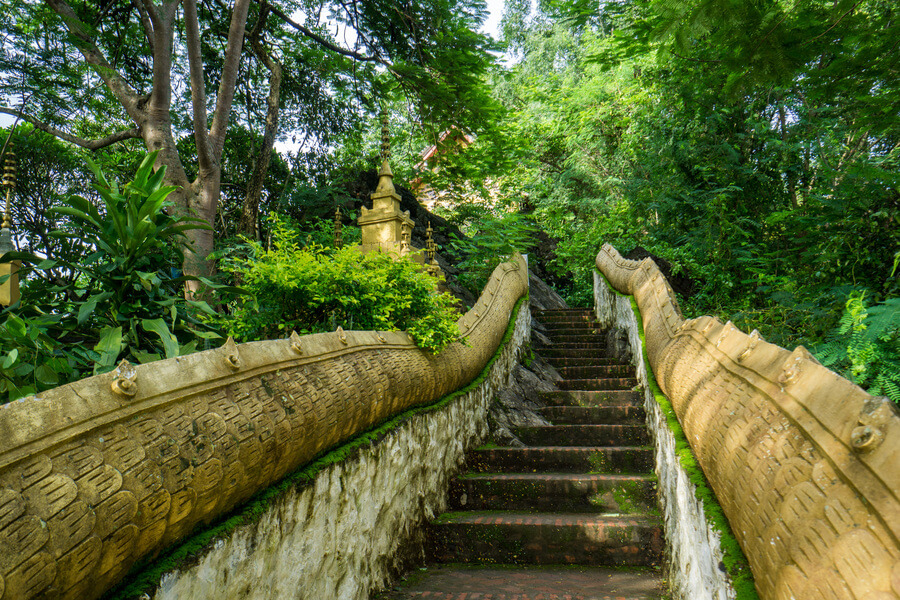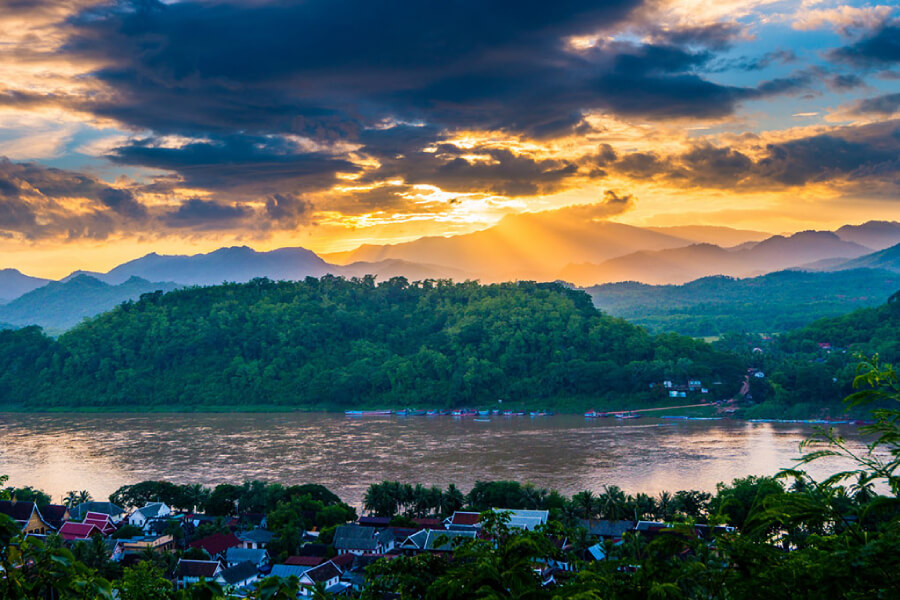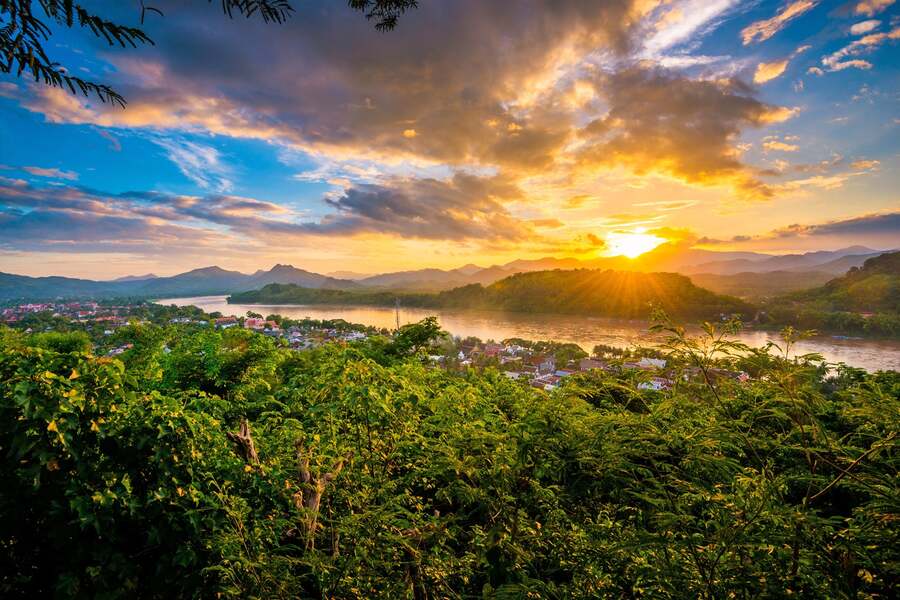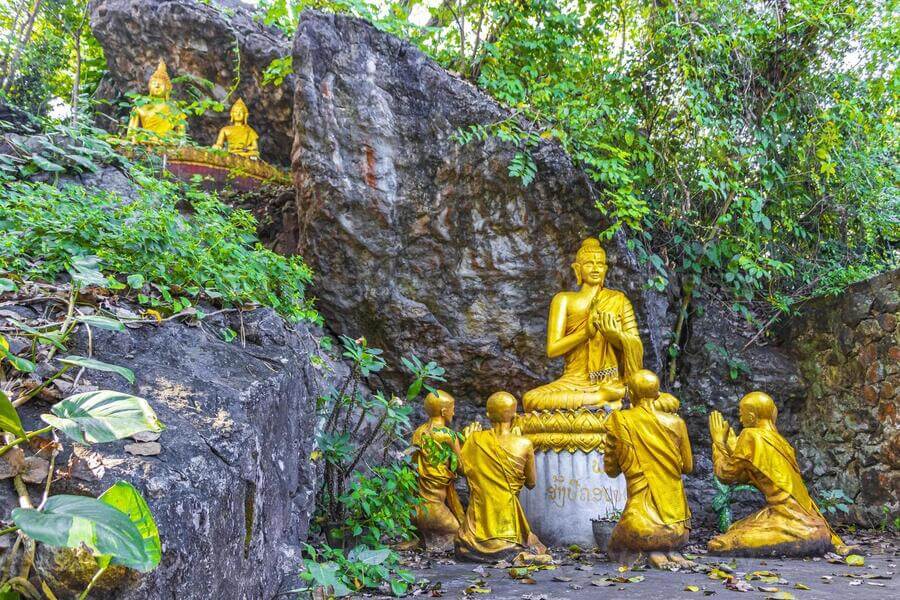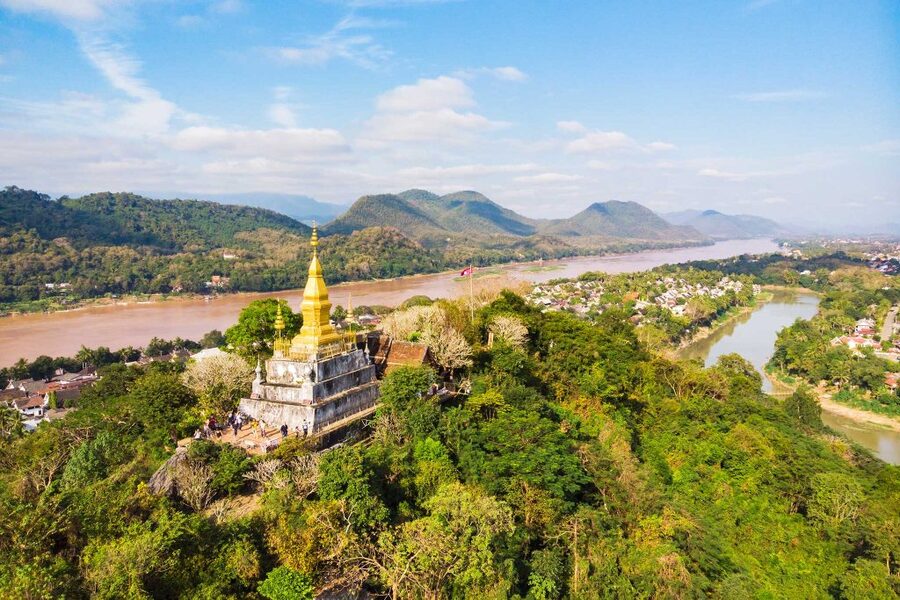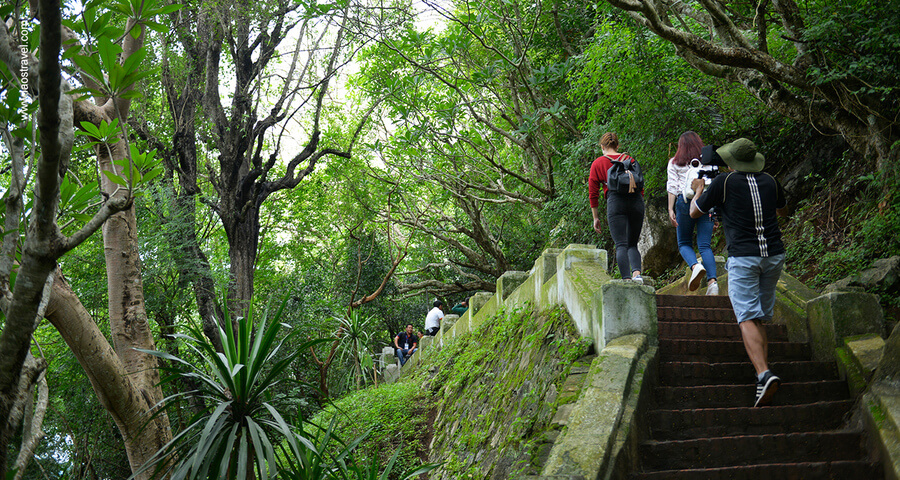Rising majestically above the enchanting town of Luang Prabang in Laos, Phousi Hill is a living testament to the town's rich history and natural beauty. With its lush greenery, ancient temples, and panoramic views of the Mekong River, Phousi Hill is not only a geographic wonder but also a spiritual and cultural center. As one ascends its stone-paved steps, a world of serenity and wonder unfolds, making Phousi Hill an essential destination for those on Laos tours seeking a deeper connection with the heritage and natural splendor of Luang Prabang.
The Rich History and Cultural Significance of Phousi Hill
Phousi Hill's history is a vibrant tapestry woven with the threads of Lao heritage. This location has been an integral part of Luang Prabang's historical landscape for centuries. Originally named "Phou Si" or "Sacred Hill," it has served as a site of enduring religious importance. Adorned with exquisite temples and shrines, it has been a sanctuary for pilgrims and spiritual seekers across generations.
Moreover, Phousi Hill's history is intricately linked with the royal legacy of Luang Prabang. Crowning its summit is the revered Wat Phra Buddhabat temple, a sacred sanctuary that enshrines Lord Buddha's footprint. The temple's historical roots extend to the early days of Luang Prabang as a royal capital.
Nevertheless, Phousi Hill's historical relevance transcends religious and royal domains. This location has borne witness to pivotal moments in Laos' history, encompassing periods of foreign colonial rule and the nation's eventual path to independence. The colonnade of white and gold Buddhist stupas atop the hill stands as a testament to the enduring spirit of Lao culture against the tide of change.
The hill's location symbolizes the UNESCO World Heritage status of the town. The designation of Luang Prabang as a World Heritage site is intricately tied to Phousi Hill, a site that resonates with the town's deep-rooted traditions and cultural heritage.
Yet, history alone does not define Phousi Hill. It is a living embodiment of Lao culture. Every year, the hill hosts vibrant festivals and celebrations, like the Lao New Year, where both locals and tourists gather to pay homage to their customs and heritage. It is a place where ancient traditions harmonize with contemporary life, and Phousi Hill's location serves as the stage where this cultural drama unfolds.
Phousi Hill is a testament to the harmonious fusion of history and culture, where the past is preserved in the present, and the location itself becomes a bridge connecting generations. It stands as a living embodiment of the Lao spirit, an indelible mark in the annals of Laos' heritage, and a cherished destination for those eager to explore the country's rich history and culture.
The Legend of Phousi Hill: A Mythical Tale
The legend of Phousi Hill weaves a captivating narrative of faith, love, and an enduring bond between a powerful king and a mythical creature. Journey back in time and immerse yourself in the enchanting myth that envelops this iconic hill.
The Beginnings: In a kingdom, known today as Laos, there once ruled a wise and just king named Chao Anou. His realm was characterized by peace and prosperity, and the people held him in high esteem for his wisdom. However, a deep sorrow burdened the king's heart: despite his wealth and power, he yearned for an heir to carry on his legacy. The king and queen fervently prayed to the heavens for a child, and their prayers were answered.
The Divine Encounter: On an auspicious day, as the king and queen strolled along the Mekong River, they encountered a celestial being named Nang Si Devi. She was the daughter of the river god, and her beauty surpassed mortal bounds. The divine maiden approached the royal couple and delivered a divine message: the queen would give birth to a son destined for greatness.
The Prophecy Fulfilled: True to the celestine prophecy, the queen gave birth to a son, a prince of unmatched beauty and wisdom. King Chao Anou named him Phousi, signifying "Sacred Hill." The young prince grew up in a land of tranquility and serenity. He was known for his compassion, intelligence, and the grace of a thousand angels. The people adored him, and his reign was marked by happiness.
The Betrayal: Yet, every story of greatness contains an element of betrayal. In this tale, it took the form of a jealous nobleman determined to seize the throne. Through a sinister plot, he conspired against the young prince. When Phousi assumed the throne, the envious nobleman spread rumors of rebellion, sowing fear and chaos among the people. The once-loyal subjects turned against their beloved prince.
The Tragic Conclusion: Amidst the turmoil of rebellion, a heartbroken Phousi fled the city and sought refuge in the sacred hills surrounding Luang Prabang. Alone and weary, he found solace in the embrace of the mythical Naga, a serpent deity believed to reside in the waters near the hill. The Naga, recognizing Phousi's purity of heart, provided shelter and guidance.
The Ascension: One fateful day, while Phousi was meditating on the hill, the Naga revealed its true form to him. With immense gratitude and love, the serpent coiled itself around Phousi and raised him high into the heavens, where he transformed into a radiant golden Buddha. From that day forward, Phousi Hill bore his name, and a sacred stupa was erected to mark the place where this miraculous transformation occurred.
The Myth Lives On: The legend of Phousi Hill continues to be a source of reverence and inspiration for the people of Luang Prabang. The annual Phousi Hill Festival, celebrated with great pomp and splendor, is a testament to the enduring love and respect the town holds for its sacred hill and the miraculous story of the prince who became a golden Buddha.
The Enchanting Sunrise Views from Phousi Hill
Every morning, a magical transformation unfolds atop Phousi Hill, a serene sanctuary in the heart of Luang Prabang. As the world awakens, this iconic hill provides a front-row seat to one of nature's most enchanting performances: the sunrise. The location of Phousi Hill makes it the ultimate stage for this daily spectacle, offering visitors a chance to be a part of something extraordinary.
The journey begins well before dawn, as eager souls ascend the stone steps leading to the hill's summit. The atmosphere is filled with anticipation as you join fellow travelers and pilgrims on a pilgrimage of a different kind. As you ascend, the world below is cloaked in shadows, and the city's temples and architecture are silhouetted against the early morning sky.
Reaching the summit is an experience in itself, as the view gradually unfolds before your eyes. The location of Phousi Hill places it at the confluence of the Nam Khan and Mekong rivers, allowing you to witness the first gentle rays of light illuminating the tranquil waters and revealing the city's charm.
The sun's fiery orb breaks free from the horizon, the sky becomes a canvas painted in hues of orange and pink. The temples and buildings of Luang Prabang come to life, bathed in the warm glow of the morning sun. The lush landscape surrounding the hill, with its trees and vegetation, adds to the natural beauty that unfolds at dawn.
But it's not just the stunning visuals that make the sunrise views from Phousi Hill enchanting. The location's significance in the spiritual fabric of Luang Prabang adds a layer of reverence to this experience. The hill is adorned with shrines and temples, and throughout the year, it is a place of pilgrimage for both locals and tourists.
The serenity that envelops Phousi Hill at sunrise is palpable. It's a moment of stillness, of being present in the here and now, and feeling the world awaken around you. Whether you're seeking a peaceful moment of reflection, a breathtaking photograph, or simply the pure joy of witnessing a new day's birth, Phousi Hill's location offers it all.
When you stand at the summit of Phousi Hill, you become part of a timeless tradition—welcoming the sun with open arms. This daily spectacle is a reminder that beauty exists in the simplest of moments and that nature, when framed by the perfect location, has the power to enchant and inspire like nothing else.
Exploring Phousi Hill's Sacred Temples and Stupas
As you embark on your journey to explore Phousi Hill, you'll uncover a treasure trove of sacred temples and majestic stupas that stand as testaments to Laos' spiritual heritage. Each of these architectural marvels bears profound significance and reflects the rich tapestry of religious devotion that graces the hill's summit.
Wat Phra Buddhabat: At the apex of Phousi Hill, Wat Phra Buddhabat reigns supreme as a beacon of spiritual enlightenment. This temple, with its glistening gold façade, enshrines the sacred footprint of Lord Buddha. Pilgrims and seekers of spiritual solace ascend the hill to pay their respects, connecting with centuries of devotion. The location of Wat Phra Buddhabat is not only the highest point in Luang Prabang but also the closest to heaven, both in terms of altitude and spirituality.
Chomsi Stupa: Standing tall and elegant at the summit of Phousi Hill is the Chomsi Stupa. Its shimmering golden spire catches the first rays of dawn and dusk, a symbolic gesture that brings blessings to those who make the climb. The stupa's location provides a panoramic view of Luang Prabang's scenic landscapes. Its intricate design and celestial symbolism make it a must-visit site for those exploring Phousi Hill.
Haw Pha Bang: Positioned amidst a lush grove of trees, Haw Pha Bang is an architectural masterpiece. This exquisite temple is not only an aesthetic wonder but also a site of immense cultural importance. It houses the Phra Bang, a sacred Buddha image believed to have protective powers over the town. The location of Haw Pha Bang symbolizes the spiritual guardianship of Luang Prabang.
Wat Thammothayalan: Tucked away in the verdant folds of Phousi Hill, Wat Thammothayalan offers a serene retreat for contemplation. The temple's tranquil location provides respite for weary travelers, a place where one can sit and reflect amidst the whispers of the surrounding trees. The location's tranquility encourages a profound connection with one's inner self.
Wat Sop Sickharam: Discover Wat Sop Sickharam, a spiritual sanctuary nestled in the leafy embrace of Phousi Hill. This temple's location offers a serene backdrop, perfect for quiet meditation and self-discovery. The temple's richly decorated exterior showcases the skillful artistry that graces every corner of Phousi Hill.
That Pathum Stupa: The graceful That Pathum Stupa adds a touch of elegance to the hill's landscape. Its peaceful location provides visitors with a sense of tranquility and an opportunity to connect with the surrounding nature. Its pristine, white exterior symbolizes purity and enlightenment.
Wat Pa Phai: Deep in the heart of Phousi Hill's lush terrain, Wat Pa Phai awaits discovery. Its location is both secluded and serene, offering a respite from the outside world. The temple's presence adds to the tranquil atmosphere that envelopes Phousi Hill.
Quiet Corners of Reflection: Beyond these prominent sites, Phousi Hill boasts numerous other temples and meditation spots that offer quiet corners for personal reflection. Whether you seek spiritual connection or a moment of peace, the hill's location provides ample opportunities for both.
While you explore each of these architectural gems, you will find yourself immersed in a world where history, culture, and devotion seamlessly converge. The hill's sacred sites not only beckon you to witness their beauty but also invite you to experience the tranquility of their location and the spiritual stories they tell.
Phousi Hill: Entrance Fee and Opening Hours
Entrance Fee
There is an affordable entrance fee of 20,000 Kip (approximately US$ 2.60) per person. This modest fee not only grants you access to the captivating world of Phousi Hill but also contributes to the ongoing efforts to safeguard its rich heritage.
Opening Hours
The enchantment of Phousi Hill begins bright and early, as the mountain opens its doors at 6:00 AM. This early start sets the stage for a pilgrimage of a different kind, where visitors, alongside pilgrims, ascend the stone steps to embrace the magic of sunrise. The hill's opening hours extend throughout the day to 7:00 PM, offering ample time to explore its temples and stupas.



